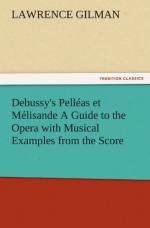XIV
[Illustration: Animez toujours]
Then begins (page 128, measure 1) a delectable episode. Over a murmurous accompanying figure given out by violas, ’cellos, harp, and horn, a clarinet sings a variant of the Melisande theme. The harmonic changes are kaleidoscopic, the orchestral color of prismatic variety. The lovely rhapsody over his beloved’s
XV
[Illustration: Moins vite et passionnement contenu]
tresses which Maeterlinck puts into the mouth of Pelleas is exquisitely enforced by the music. There is ravishing tenderness and beauty here, and an intensity of expression as penetrating as it is restrained. As Melisande’s doves come from the tower and fly about the heads of the lovers, we hear, tremolo in the strings, a variation of her motive. Golaud enters by the winding stair, and the threatening phrase quoted as Ex. XI is heard sombrely in the horns, bassoons, violas, and ’cellos—its derivation from Golaud’s own theme (see Ex. VI) is here apparent. The latter motive sounds, p, as he warns Melisande that she will fall from the window if she leans so far out. It is followed by the Fate theme as he departs, laughing nervously. A short interlude is evolved from the Melisande theme (the Pelleas motive forming a counterpoint), and the Fate and Vengeance motives—the latter outlined, over a roll of the timpani and a sustained chord in the horns and wood-wind, by a muted trumpet, pp.
No new thematic matter is presented during the two succeeding scenes (in the vaults under the castle and, afterward, on the terrace), nor are there significant reminiscences of themes already brought forward. The music of the vault scene forms a pointed commentary on the implications of the action and dialogue—in character it is dark-hued, forbidding, sinister. As Golaud and Pelleas emerge from the vaults, much use is made in the orchestra of a jubilant figure in triplets (first given out fortissimo by flutes and oboes, over an undulating accompaniment, on page 152, measure 1) which seems to express a certain irresponsible exuberance on the part of Pelleas; it accompanies his light-hearted remarks about the odor of the flowers, the sheen of the water, and the invigorating air, as they come out upon the sunlit terrace. As the scene changes again, a very short interlude introduces a new theme—that of Little Yniold, Golaud’s son, whom he is to use as the innocent tool of his suspicions. This motive, which occurs repeatedly during the ensuing scene, is one of the less important, but most typical and haunting ones, in the entire score. It is first presented (page 158, measure 4) by the oboe, doux et expressif:
XVI. YNIOLD
[Illustration: p doux et expressif]




